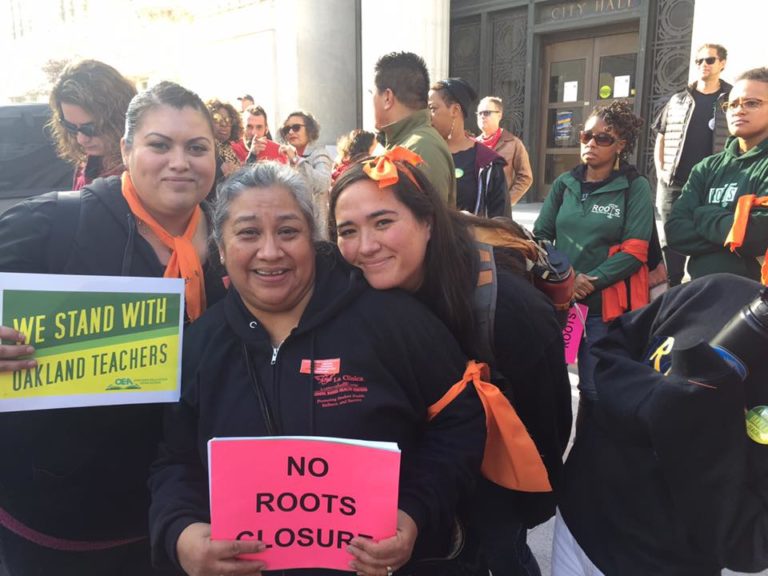Parents Ask: “Who’s Behind Roots School Closure?”
Jan 19, 2019
“Who are really the key players here. It appears board members don’t have any control,” said a Roots parent

By Ken Epstein
The Oakland Unified School District is moving full throttle with the closing of Roots International Academy, even though the proposal has not yet been approved by the Board of Education and though the district so far has not determined how much money closing the school would save, if any.
Nor does the district provide answers why the up to 24 schools that are being considered for closure are in flatland East Oakland and West Oakland neighborhoods. None of those affected are Oakland’s 44 charter schools or schools that serve more affluent students.
Studies about the wave of closures across the country, which have hit predominately Black and Latino schools, indicate that school districts save no money and that the long-lasting effects are detrimental to the education of students who are displaced as well as those who attend the receiving schools.
A big question about the closing of Roots, located at 66th Avenue and International Boulevard in East Oakland, is one about democracy: Who made the decision to close the school if it is not the elected school board.
School district officials say that the decision to close the school in June means they have to move ahead quickly, so Roots students will have other schools to attend in the fall. The board is scheduled to discuss the issue on Jan. 23 and make the final decision Jan .28 at a special meeting.
According to OUSD spokesman John Sasaki, “Staff is making a recommendation, and the school board will make the final decision.”
However, the administration seems to have been decided the issue without waiting for the board to act on its recommendation. Supt. Kyla Johnson-Trammell met with the Roots community in December, the week before the holiday break, to notify teachers and parents that their school would close.
The district is already starting to counsel students and parents about other schools in East Oakland they can attend next year instead of Roots. No decision has been announced about paying for bus transportation for the families.
And CCPA (Coliseum College Prep Academy), the more favored public school that shares the campus with Roots, called a meeting this week about what to do with all the extra classroom space once Roots shuts down.
“Parents are invited to give input about CCPA’s expansion plan. Roots is scheduled to close next year, and CCPA is planning to grow to serve more students in the community,” according to a CCPA newsletter. The CCPA administration told parents the school is not willing to take more than about a half dozen current Roots students.
“What’s the real deal? Who made the decision? Asked Sylvia Ornelas, a parent leader at Roots.
“We’re not getting any answers,” she said. “Who are really the key players here? It appears the board members don’t have any control.”
The Oakland Post this week filed a Public Records Act (PRA) Request with the district asking for communications related to Roots and other school closings.
In addition to communications and reports by district officials, the PRA requested said, “The documents should include exchanges with the Fiscal Crisis Management and Assistance Team (FCMAT), the Alameda County Office of Education, Oakland’s state-appointed trustee, representatives of the State Department of Education and atate legislators and representatives of GO Public School, Educate78, New Schools Venture Fund and the California Charter School Association.”
Asked why the district objects to sending current Roots students to CCPA, which would minimize disruption of the tightknit Roots school community, District spokesman Sasaki emphasized that the merging of the two adjacent schools would have a harmful impact on students.
“Merging the two schools was not an option as that would have been too disruptive for all the students, families and staff,” he said
Presumably, displacing Roots families to schools around East Oakland – Elmhurst Community, Greenleaf, Madison Park Upper and Urban Promise Academy, according to the district – would not disrupt the educational stability of those schools or the displaced students.
Sasaki said the reason for closing Roots has to do with saving money and efficiency:
“All the changes the district is look at are aimed at making the district function more efficiently with better schools while saving money. The changes for Roots have to do with declining enrollment and problems with staff retention.”
However, Sasaki says the district still not know how much will be saved by closing the school.
“The district is still working to determine what the savings will be with the closure of Roots,” according to KQED, citing an email from Sasaki.
In a strong statement of support for Roots, Oakland Education Association (OEA) President Keith Brown said:
“Our association firmly believes that every student deserves a quality public education. So, we are dismayed by discussion of school closures and consolidations, particularly in Black and Brown neighborhoods. We should be building up our community schools, not shutting them down.”